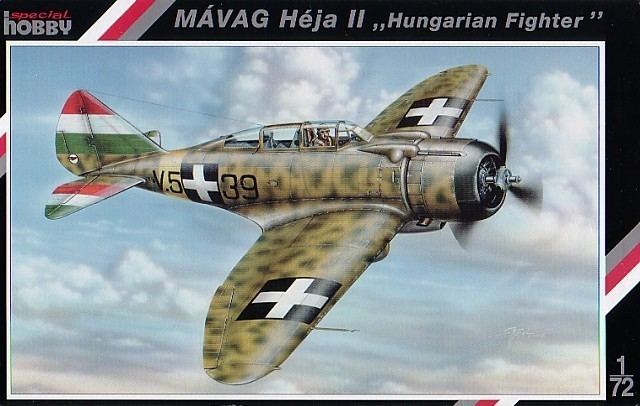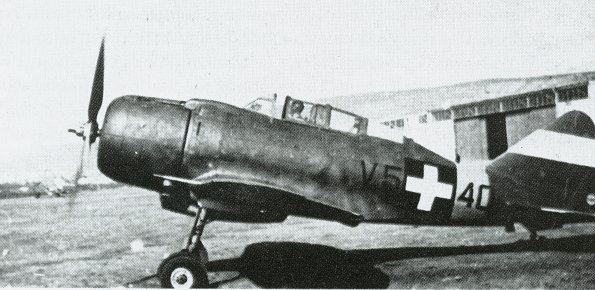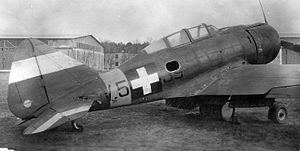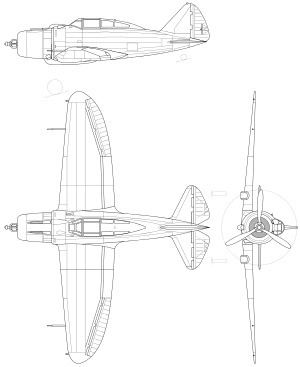Wingspan 11 m | Length 8.39 m | |
 | ||
M vag h ja 1942
The MÁVAG Héja ("Hawk") was a Hungarian fighter aircraft based on the Italian Reggiane Re.2000.
Contents
- M vag h ja 1942
- Il 2 sturmovik 1946 m vag h ja re 2000
- Design and development
- Operational history
- Operators
- Specifications Hja II
- References
Il 2 sturmovik 1946 m vag h ja re 2000
Design and development

In December 1939 seventy Reggiane Re.2000 fighters, purchased from Italy, were delivered to the Magyar Királyi Állami Vas-, Acél- és Gépgyárak, ("Royal Hungarian State Iron, Steel and Machine Works"), where they were modified into MÁVAG Héja I ("Goshawk I") fighters. The original Piaggio P.XI engines were replaced by the Hungarian-built Manfred Weiss WM K-14 driving Hamilton Standard three-bladed, constant-speed propellers. The WM K-14 was a licensed copy of the French Gnome-Rhône 14K engine that necessitated a 1-foot 3-inch lengthening of the fighters’ forward fuselage, to restore the center of gravity to a safe position. The Piaggio engine was itself also a copy of the Gnome-Rhône 14K, but less reliable than the original.

A decision was soon made to produce more Héja fighters under license in Hungary as the MÁVAG Héja II (Goshawk II). The new Héja II was entirely Hungarian with locally produced airframes, engines and armament. The new fighter differed from the Reggiane fighter in a number of ways. Armament was changed to twin 0.50 inch (12.7 mm) Gebauer fixed forward-firing guns in the upper nose with 300 rounds each. Length was 27 ft 6.25 inch (8.39 m), and maximum level speed was 301 mph (485 km/h) at 13,780 ft (4,200 m). Endurance was 2 hours and 30 minutes. The first MÁVAG Héja II took to the air on 30 October 1942, and in total MÁVAG built a further 203 Héjas for the Royal Hungarian Air Force. The last aircraft was completed on 1 August 1944 when production ceased.
Operational history

The Kingdom of Hungary was allied to Nazi Germany during World War II, with at least one Hungarian squadron flying the MÁVAG Héja in combat on the Eastern Front. However, most Héjas operated inside Hungary in an air defense role or as a trainer.

On 20 August 1942, personal tragedy struck the Hungarian Regent Miklós Horthy, when 37-year-old István Horthy, Horthy's eldest son, Deputy Regent of Hungary and a Flight Lieutenant in the reserves, was killed while flying Heja V.421 of 1/1 Fighter Squadron Royal Hungarian Air Force near Ilovskoye.

In 1943, 98 Héjas were produced and another 72 in 1944. They were regarded as no longer suitable for combat against modern Soviet fighters and should have served as fighter trainer only. The Luftwaffe was reluctant to re-equip its Hungarian ally: the deliveries of aircraft went primarily to front-line formations and there was still danger of a Hungarian-Romanian conflict. Moreover, Hitler held an extremely bad opinion of the Hungarian aviators. So, the Hungarian Air Force was forced to use the licence-built Reggiane.

The last offensive sortie of the Hejas took place on 2 April 1944, when 180 15th Air Force USAAF bombers, escorted by 170 fighters, bombed the Danube Aircraft Works in Budapest and other targets. The Fighter Control Centre dispatched one wing of Hejas from 1/1 Fighter squadron, along with a couple of Messerschmitt Me 210Cas and 12 Bf 109Gs. The Honvéd pilots claimed 11 American aircraft (six of them confirmed). USAAF pilots reported to have shot down 27 Hungarian aircraft, while only two Hungarians were killed.
Operators
Hungary
Specifications (Héja II)
Data from The Complete Book of Fighters
General characteristics
Performance
Armament
